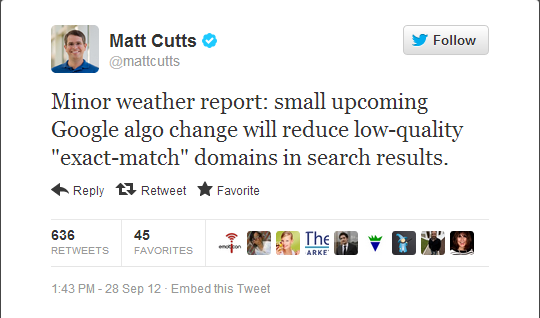Google recently announced an exact match domain (EMD) algorithm update intended to ensure low-quality EMDs do not rank well in Google search results. Matt Cutts tweeted that the update would “impact 0.6% of English-US queries to a noticeable degree.” So far, the update has had a heavy-handed impact on websites that have built their SEO strategy around an EMD, leaving major brands untouched.
Historically, an EMD was a boon for webmasters and particularly affiliate marketers seeking an easy way of reaching the top of SERPs on target keywords. It made it possible for a domain like purses.org to go head to head with Amazon and Zappos on the keyword “purses” in search results. Now, webmasters will need more than a hot domain name to rank. They’ll have to back it up with quality content, back links, and no spammy tactics, or risk penalization like purses.org which fell from #3 behind Amazon.com and Zappos.com to #32 within 24 hours of the update.
Though it’s difficult to pinpoint Google’s definition of low quality – take purses.org, which does in fact sell purses (ironically fulfilled by Amazon) – what we know for sure is Google’s algorithm detects patterns. So when Google says a website is low quality it means it exhibits patterns commonly identified with spammers. This includes aggressive keyword usage, low-authority and spammy link-building. Aggressive keyword usage, however, is a complex indicator when you consider legitimate cases where a particular keyword would be used naturally in back links. For example, when a brand name is also a keyword, like Canada Drugs.
This complexity may explain why low quality EMDs avoided “Pandalization” to begin with. In 2011 Google announced an algorithm update called Panda aimed at lowering the rank of low quality or “thin” sites. It’s conceivable that EMDs were excluded to protect legitimate brands that have keywords in their name and in the bulk share of their back links. Cutts also stated that this update was not related to either Panda or Penguin. But this recent change suggests that Google was not satisfied with the results and that an EMD targeted update was needed.
Microsites are another target of the EMD update. A long hallmark of affiliate marketing, the microsite is typically an EMD site built around a highly specific term (like sweaters) that often derives revenue from some form of PPC advertising. Many brands that do not rely on microsites for advertising revenue use them to drive relevant traffic from the topically focused mircosite to their branded ecommerce website. But because Google is tilting the field towards unique branded domain names, consistent social signals, original content and a large portfolio of back links from high-PageRank sites, it could be that the era of microsites is over.
The end game is this: websites that overly-rely on an EMD to rank are being cleared away so that more reputable brands like Zappos, Target, Coach and Amazon can assume top billing in SERPs. While there’s no indication that an EMD alone is bad for SEO – brands should use their brand name for their domain name, whether it’s an EMD or not – building SEO strategy on an EMD is an SEO no-no.

